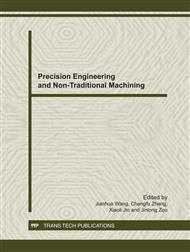[1]
Eunice S Lee, Dwight Howard, Enzhu Liang, etal. Journal of Micromechanics and Microengineering, 14(2004)535–541.
Google Scholar
[2]
R Wüthrich, L A Hof, A Lal, etal. Journal of Micromechanics and Microengineering, 15(2005)268–275.
Google Scholar
[3]
V. Fascio, R. Wüthrich and H. Bleuler. Electrochimica Acta, 49(2004): 3997–4003.
DOI: 10.1016/j.electacta.2003.12.062
Google Scholar
[4]
R Wüthrich, L A Hof. International Journal of Machine Tools &Manufacture, 46(2006)828–835.
Google Scholar
[5]
Abbas N M, Solomon D G and Bahari M F. Int. J. Mach. Tools Manuf, 47(2007)1214–28.
Google Scholar
[6]
Zhixin J, Jianhua Z and Xing A. J. Mater. Process. Technol, 53(1995) 811–16.
Google Scholar
[7]
Kim D J, Yi S M and Lee Y S. J. Micromech.Microeng. 16(2006)1092–7.
Google Scholar
[8]
Yeo S H, Choo J H and Sim K H A. J. Micromech. Microeng. 12(2002)271–9.
Google Scholar
[9]
Min-Seop Han, Byung-Kwon Min1 and Sang Jo Lee. Journal of Micromechanics and Microengineering, 19(2009)1-8.
Google Scholar
[10]
Y.S. Wong, L.C. Lim, I. Rahuman, W.M. Tee, J. Mater. Process.Technol, 79 (1998) 30–40.
Google Scholar
[11]
P. Felsenthal, B. Vonnegut, J. Appl. Phys, 18 (1967) 1801–1806.
Google Scholar
[12]
L. Dascalescu, A. Samuila, R. Tobaz´ eon, J. Electrostatics 36 (1996)253–275.
Google Scholar
[13]
W.S. Zhao, Q.G. Meng, Z.L. Wang, J. Mater. Process. Technol. 129 (2002)30–33.
Google Scholar
[14]
T.Matsuyama,H.Yamamoto, J. Phys. D: Appl. Phys.28 (1997) 2418–2423.
Google Scholar
[15]
Min-Seop Han, Byung-Kwon Min, Sang Jo Lee. Journal of Materials Processing Technology 191 (2007) 224–227.
Google Scholar
[16]
B. Bhattacharyya, S. Mitra ,A.K. Boro.Robot. Comput. Integrated Manuf,18 (2002) 283-289.
Google Scholar
[17]
Y Liu, Z. Jia and J. Liu, J. Mater Process.Technol, 69(1997)198-202.
Google Scholar
[18]
M.-S. Han, B.-K. Min and S. J. Lee,Proceedings ofISEMXV, (2007)451-455.
Google Scholar
[19]
Min-Seop Han, Byung-Kwon Min and Sang Jo Lee. International Conference on Smart Manufacturing Application,(2008)251-254.
Google Scholar


